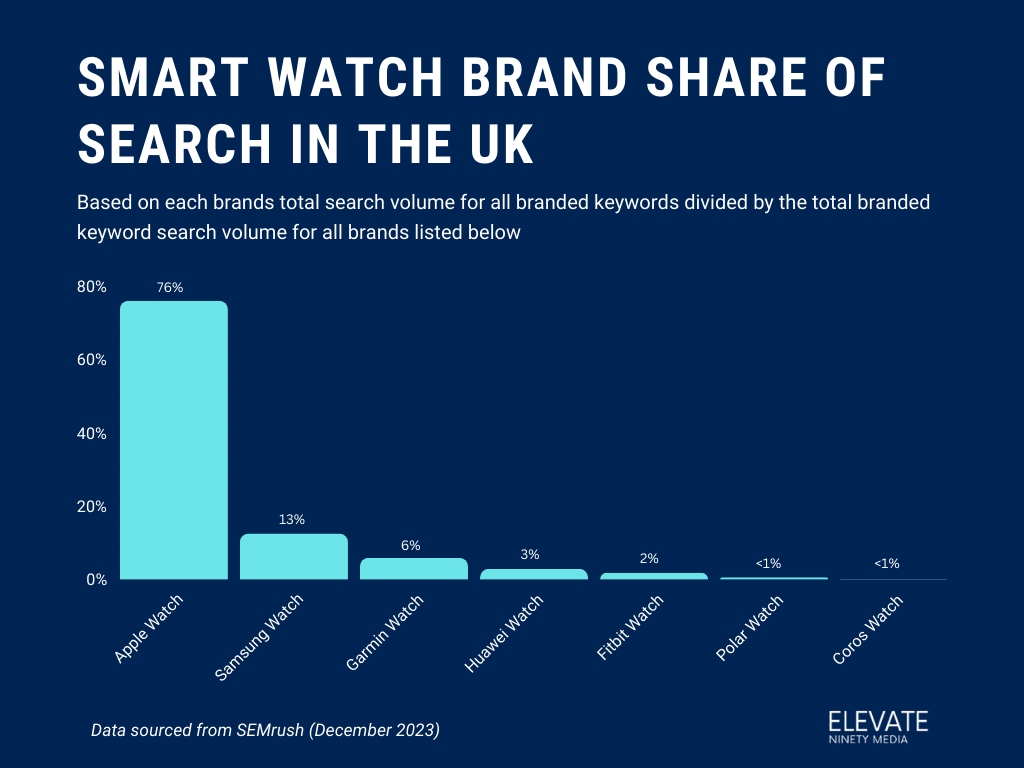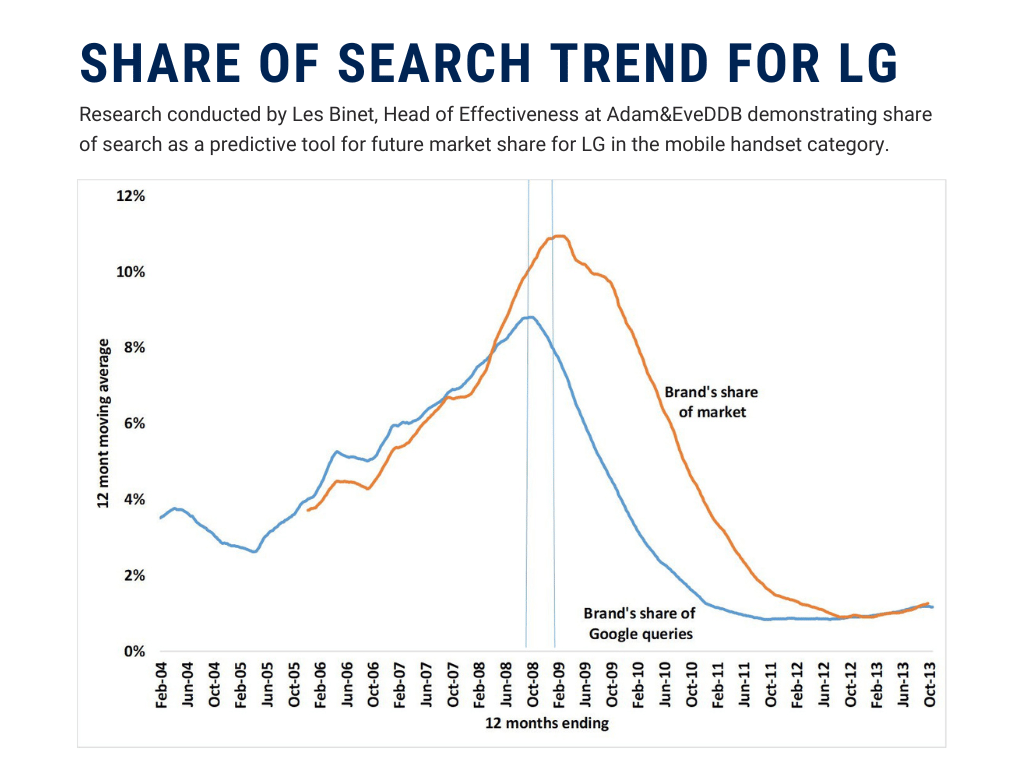In the ever-evolving landscape of digital marketing, brands across industries are constantly searching for new ways to gauge their online presence and performance. In the realm of health and wellness, where competition is fierce and consumer awareness is paramount, a metric known as “share of search” has emerged as a vital tool for success. This article explores the concept of share of search, its significance for health and wellness brands, methods of measurement, and strategies to enhance it.
What is Share of Search?
Before diving into the importance of share of search for health and wellness brands, it’s essential to understand what this metric actually entails. Share of search refers to the proportion of total online search queries related to a specific industry, brand, or product that a particular brand or website captures.
In simpler terms, it’s a measure of how often your brand’s name or related keywords appear in search engine queries compared to your competitors. The idea is that the more frequently your brand is searched for or mentioned online, the more likely it is to be top-of-mind for consumers.
The example below shows an estimate of share of search for popular smart watch brands that measure health and fitness metrics. In this example we have analysed which brand has the highest to lowest share of search based on keyword data. As you can see, Apple and their range of smartwatches dominate the share of search for health and fitness tracking.

How does Share of Search Differ to Share of Voice?
Share of search and share of voice are two distinct metrics used in marketing. Share of search primarily gauges a brand’s presence in online search queries, indicating how often it appears in consumer searches compared to competitors. It is closely tied to consumer intent, offering insights into what consumers actively seek online. Share of search is predictive and relevant in industries where online research is crucial.
On the other hand, share of voice measures a brand’s visibility across a wide range of media channels, including advertising, social media, and public relations. It encompasses data from various sources and reflects a brand’s promotional efforts. Unlike share of search, share of voice is a lagging indicator, showcasing past marketing and advertising investments and offering a competitive benchmarking perspective. Depending on a brand’s objectives and context, one or both of these metrics can be valuable for assessing its market impact and competitiveness. However, share of search is becoming the preferred metric brands are using to track marketing effectiveness and market share as we further explain below.
Why is Share of Search Important for Health and Wellness Brands?
1. Increased Visibility
For health and wellness brands, visibility is everything. Share of search provides insights into how often consumers are actively looking for information, products, or services related to health and wellness. By tracking this metric, brands can gauge their visibility within this competitive space and adjust their marketing strategies accordingly.
2. Competitive Benchmarking
Health and wellness is a saturated market, with numerous players vying for consumer attention. Share of search allows brands to benchmark themselves against competitors. It helps in identifying who is dominating the online landscape and who needs to step up their game. Analysing this data can uncover valuable insights into market trends and consumer behaviour.
3. Consumer Engagement
Share of search is not just about being seen; it’s also about engaging with consumers. Brands that consistently appear in search results can build trust and credibility among their target audience. When consumers see a brand mentioned frequently in their online searches, it fosters a sense of familiarity and reliability.
4. Market Trends and Insights
Staying in tune with market trends and consumer preferences is crucial for health and wellness brands. Share of search data provides real-time insights into what consumers are actively searching for, allowing brands to tailor their offerings and content to align with these trends.
How Do You Measure Share of Search?
Measuring share of search involves a combination of data analysis and tracking tools. Here’s a step-by-step guide on how to measure this vital metric:
1. Keyword Research
Start by identifying a list of relevant keywords and phrases related to your health and wellness brand. These keywords should reflect the products or services you offer and align with what your target audience is likely to search for.
In the example above for smart watches, we created a list of keywords for all keywords related to “[brand name] + watch + query” e.g. “Garmin watch running”.
2. Data Collection
Utilise various analytics and SEO tools to collect data on how often these branded keywords are searched for on popular search engines like Google. Keyword popularity is often measured in ‘search volume’ which provides a measure of how many times users have typed in the branded keywords into a search engine. Tools such as Google Trends, and keyword research platforms can provide valuable data on search volume and trends.
Using the example above we used SEMrush to analyse the volume of search for branded keywords related to each brand. The results are shown in the table below:
| Watch Brand | Average Monthly Search Volume |
| Apple Watch | 5,033,840 |
| Samsung Watch | 830,590 |
| Garmin Watch | 390,040 |
| Huawei Watch | 189,680 |
| Fitbit Watch | 120,450 |
| Polar Watch | 37,390 |
| Coros Watch | 6,100 |
| Total | 6,608,090 |
3. Competitor Analysis
To calculate share of search accurately, you need to compare your brand’s search volume to that of your competitors. Identify your main competitors in the health and wellness space and collect data on their keyword rankings and search volumes as shown in the table above.
4. Calculation
Calculate your share of search by dividing your brand’s search volume for specific keywords by the total search volume for those keywords in your industry. Multiply the result by 100 to get a percentage. The formula can be expressed as:
Share of search = (Your brand’s search volume / Total industry search volume) x 100
From our share of search example for smart watches, the table below shows the results once we applied the above formula:
| Watch Brand | Average Monthly Search Volume | Share of Search |
| Apple Watch | 5,033,840 | 76.18% |
| Samsung Watch | 830590 | 12.57% |
| Garmin Watch | 390040 | 5.90% |
| Huawei Watch | 189680 | 2.87% |
| Fitbit Watch | 120450 | 1.82% |
| Polar Watch | 37390 | 0.57% |
| Coros Watch | 6100 | 0.09% |
| Total | 6,608,090 |
5. Regular Monitoring
Share of search is not a one-time metric; it requires continuous monitoring and tracking. Regularly update your keyword list, analyse changes in search volumes, and adapt your marketing strategies accordingly.
Using Share of Search as a Predictive Measure of Market Share
Share of search is not just an isolated metric but can also serve as an accurate and predictive measure of market share. This connection between share of search and market share is grounded in the idea that consumer behaviour, particularly online search behaviour, is closely linked to actual purchasing decisions. Here’s how share of search can be a reliable indicator and predictor of market share:
1. Consumer Behavior Analysis:
- Intent to Purchase: When consumers actively search for specific products or services online, it often indicates a strong intent to purchase. They are in the consideration phase of the buying journey, actively seeking information or options. Brands that capture a significant share of these search queries are more likely to convert these leads into customers.
- Information Gathering: Consumers often turn to search engines to research products or services before making a purchase. They search for reviews, product specifications, prices, and comparisons. Brands that are frequently mentioned in these searches are seen as authoritative sources and are more likely to influence consumer decisions.
2. Strong Correlation with Market Share:
- Historical Data: Research has shown that there is a strong correlation between a brand’s share of search and its market share. Brands with a higher share of search often tend to have a larger market share. This correlation is particularly evident in industries where online research and information play a significant role in the buying process, such as health and wellness.
- Tracking Over Time: Over time, as a brand consistently maintains or improves its share of search, it’s likely to experience corresponding growth in its market share. Conversely, a declining share of search could indicate potential challenges in maintaining or growing market share.
3. Predictive Power:
- Leading Indicator: Share of search can function as a leading indicator of market share trends. It provides insights into shifts in consumer preferences and trends before these changes are fully reflected in actual sales data. This gives brands an opportunity to proactively adapt their strategies.
- Competitive Benchmarking: By comparing your share of search to that of competitors, you can identify emerging threats or opportunities in the market. A sudden surge in a competitor’s share of search could signal a potential market share challenge that needs attention. Conversely, a sudden drop in a competitor’s share may represent a market opportunity.
4. Cost-Effective Insights:
- Data Availability: Share of search data is often readily available through various analytics tools and platforms. It can be a more cost-effective and timely way to gain insights into market dynamics compared to traditional market research.
- Adjusting Marketing Strategies: Armed with share of search insights, brands can make data-driven decisions to optimise their marketing efforts. They can allocate resources more effectively, target the right keywords, and tailor their messaging to align with what consumers are actively searching for.
The video below shows research conducted by Les Binet, Head of Marketing Effectiveness at Adam&EveDDB, that found that share of search can predict market share “sometimes up to a year ahead”.
The image below highlights the research shown in Les Binet’s video above. It demonstrates that for LG, in the mobile handset category how the share of search trend provided a 6 month predictive tool for the future trend of market share. Further demonstrating how effective share of search can be used as a predictive tool for market share and marketing effectiveness.

How Can You Improve Share of Search?
Now that you understand the significance of share of search for health and wellness brands and how to measure it, let’s explore strategies to enhance this crucial metric:
1. Content Optimisation
Create high-quality, informative, and engaging content that aligns with the keywords your target audience is searching for. Regularly update your website and blog with relevant content that addresses their needs and concerns. It’s important to keep up to date on search queries, topics and industry trends to ensure your content is relevant and in-line with your customers needs. As highlighted in Les Binet’s research above, LG may have been able to prevent their loss of market share if they were able to align their marketing efforts with current trends to maintain their growth in share of search.
2. SEO Best Practices
Implement SEO best practices to improve your website’s search engine rankings. Optimise your website for mobile, improve page load times, and focus on both on-page and off-page SEO techniques.
3. Social Media Engagement
Leverage the power of social media to engage with your audience and increase your brand’s online presence. Share informative content, engage in conversations, and encourage user-generated content.
4. Paid Advertising
Invest in paid advertising campaigns, such as Google Ads, to increase your brand’s visibility in search results. Target specific keywords and demographics to reach your ideal audience.
5. Influencer Marketing
Collaborate with influencers in the health and wellness niche to promote your brand. Influencers can help increase brand mentions and search queries related to your products or services.
Share of Search is A Vital Metric for Success
In conclusion, share of search is a vital metric for health and wellness brands seeking to thrive in the digital age. By understanding what share of search is, why it matters, how to measure it, and how to improve it, these brands can effectively navigate the competitive landscape, engage with their audience, and stay ahead of industry trends. Embracing this metric as a key performance indicator is a step toward long-term success in the ever-evolving world of health and wellness marketing.
Also, Brands that pay attention to their share of search, monitor it regularly, and use it as a strategic tool can predict future market share trends and make better informed decisions to maximise their market share.





